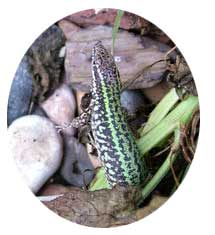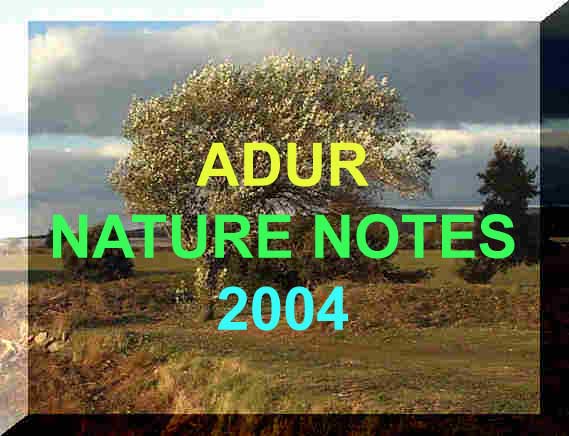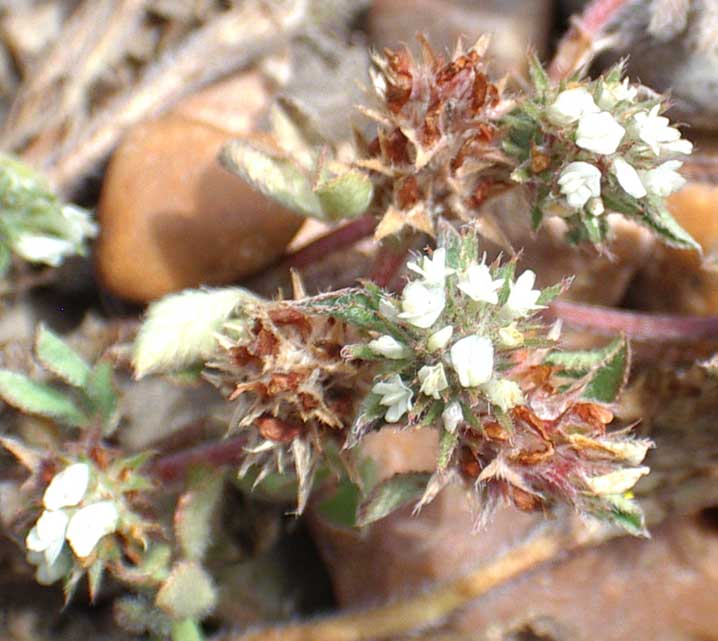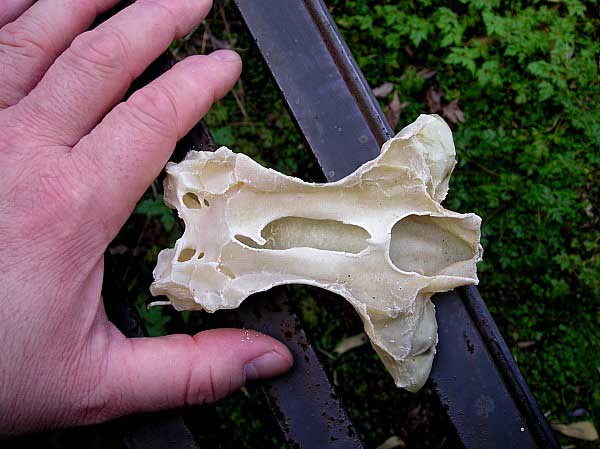Coastal
Zone
THE
ADUR SHORE
Shoreham,
Southwick and Lancing beach areas above High Tide mark
|
Overview
Shoreham
Beach is a shingle spit about three miles long, separated from town of
Shoreham-by-Sea (Sussex) by the River
Adur, which been has deflected eastwards by the
longshore
drift over the centuries. Wood and rock groynes have been installed
to stabilise the moving shingle and to minimise erosion and prevent flooding.
Coastal
Wildlife 2006 (Link)
Wildlife
Reports
10
December 2005
At
low tide on the sand on the beach by Widewater,
two Oystercatchers
and handful of Common Gulls
were noted as nothing unusual with a score or more omnipresent Black-headed
Gulls.
9 December
2005
On
the pebbled shore by the Old Fort, there were a dozen Pied
Wagtails in each of three directions when
I looked east, south and west, as I was standing on the strandline
littered with seaweed, whelk shells and dozens of whelk
egg cases. There were about a hundred Starlings
that rose as a flock and a handful of brown speckled pipits, probably
Rock
Pipits* searching for morsels amongst
the debris washed up. (* These small
brown birds were diffcult to pick out amongst the seaweed and pebbles and
were only discovered after a scan with my binoculars. Because their legs
appeared to be orangey or paler in colour and did not appear to be black,
these could be Meadow Pipits?)
8 December
2005
Nothing
newsworthy to record on the pebbles adjacent to Beach Green, Lancing, where
the usual two dozen plus Crows
were scavenging and a few were dropping molluscs on to the rock sea defences.
Pied
Wagtails were prominent with a half a
dozen seen on Lancing beach and more in Shoreham and Worthing.
16
November 2005
A
Snow
Bunting was seen at Shoreham Old Fort
on the west side of the entrance to Shoreham Harbour. The
Sussex
Ornithological Society classifies
this bunting as
a scarce passage migrant or winter visitor.
15
November 2005
There
were hundreds of Slipper Limpet chains,
Crepidula
fornicata, washed on the
strandline
on Southwick Beach. These molluscs were probably
washed up during the gales last week as
all the shells were dead and could be prised apart easily revealing the
orange flesh inside.

BMLSS
Molluscs
Oyster
& the Slipper Limpet
13
November 2005
A
flock of at least seven Stock Doves*,
Columba
oenas, flew rapidly in off the sea in a very direct due north direction
over Shoreham Beach Green and then over Shoreham town.
*
I
am unfamilar with these birds that looked different from a normal pigeon,
faster in flight and smaller than Wood Pigeons,
but larger than Collared Doves.
The identification is only a best guess and has not been confirmed.
12
November 2005
Another
Grey
Phalarope was seen and photographed at
the western end of Widewater Lagoon, Lancing
until early afternoon when it flew off. Also two Black
Redstarts
and a late Wheatear
on the beach.
Phalarope
Picture Page
29
September 2005
As
more Wheatears
were leaving: two were seen at the east end of Widewater,
a Red Admiral Butterfly was
seen flying directly and rapidly in off off the sea (at head height) by
the Half Brick in east Worthing. This was the first time I was able to
confirm a probable immigrant butterfly actually
flying in off the sea like that. The wind
direction was WSW.
19
September 2005
The
sunset (7:15 pm)
on a exceptionally low equinoctial spring tide on Lancing
Green beach, was a thin ribbon of red sky that outlined Worthing Pier
three miles to the west. Dark skies were illuminated by a huge* Full
Moon rising in the eastern sky around 8:00
pm.
(*
the large size was an optical illusion.)
At
the same time, a young Fox
cocked his leg in the road just to the east of the Church of Good Shepherd
and ran on to the shingle beach, where for a few seconds it was a silhouette
on the brow of the pebbles where it was  joined
by another Fox
only three metres apart before they both disappeared out of sight on to
the beach below the high tide mark. joined
by another Fox
only three metres apart before they both disappeared out of sight on to
the beach below the high tide mark.
12
August 2005
The
unmistakable white rump of the Wheatear
was just confirmation of at least three birds by Widewater
about to embark on their long migration south for the winter.
There
was some Rock Rose
just south-east of the Footbridge
on the riverbank.
3 August
2005
At
least four greenish Wall Lizards, Podarcis, were seen skittering
along the bottom of the flint walls of the Old
Fort and one of them was seen poking its small head out of a brick-sized
cavity at ground level. They will all far to quick and sudden to photograph.
A male Common Blue Butterfly fluttered
around the grasses by the Old Fort. There
was a small mushroom as well.
On
Silver Sands, the Childing Pink, Petrorhagia
nanteuilii, had almost finished flowering
and there were no double flowers to be seen.
26
July 2005
 An
area of several square metres on or even below the high tide mark ws covered
in prostrate green vegetation of the Spear-leaved Orache, east Worthing,
west of the Brooklands outfall pipe. A plant of Great
Lettuce was also recorded on the edge of the
new cyclepath. An
area of several square metres on or even below the high tide mark ws covered
in prostrate green vegetation of the Spear-leaved Orache, east Worthing,
west of the Brooklands outfall pipe. A plant of Great
Lettuce was also recorded on the edge of the
new cyclepath.
Intertidal
Report
16
July 2005
A
very green Wall Lizard, Podarcis, was spotted on the Old
Fort shingle near the remains of the fortress walls.
14
July 2005
On
Silver
Sands on Shoreham
Beach, the first double flower of the Childing
Pink, Petrorhagia
nanteuilii, was recorded for this
year. There are many less plants this year, not many more than thirty,
as Kidney Vetch
and other plants have invaded. A small patch of Rough
Clover was recorded near the Old
Fort.
The
temperature reached 25.1 ºC but the humidity never fell below 59%
which was exceptional for a warm sunny day.
9 July
2005
The
handful of smallish white butterflies discovered
fluttering inside the stems of the Sea Kale
on Lancing Beach (between Widewater and
Lancing Beach Green) have been identified with difficulty as Small
White Butterflies. These were not the
only butterflies in flight and were outnumbered by larger white butterflies
with black tips to their wings. About a dozen refused to settle, but the
one that did was identified as a Green-veined
White. There were no white butterflies
observed over the sections of the beach (Worthing) that did not contain
Sea
Kale.
Adur
Butterfly & Large Moth List 2005
21
June 2005
On
Silver
Sands, Shoreham Beach, Kidney
Vetch has invaded and almost taken over
the designated Childing Pink, Petrorhagia
nanteuilii, area, but these small
mauve-pink flowers have spread to their preferred sandy habitat, an area
between the Harbour Club and the river. They are not in double flower yet
which is characteristic of this plant. The Kidney
Vetch was just past flowering, and it was
also found on the grass foreshore opposite the Lifeboat Station on the
Shoreham Beach peninsular side of the Adur
estuary.
On
Old Fort, a single Wall Lizard, Podarcis,
poked
his head out of a hole in the flint wall, for a fraction of a second three
times. It was the only one spotted in the middle of the day. The large
shingle plants of Tree Mallow,
Red
Valerian,
Sea Kale, Viper's
Bugloss and Silver
Ragwort spread our of the undisturbed
shingle foreshore. Two species of ground hugging Stonecrops
were in flower, with Bird's Foot Trefoil,
but the expanse of Starry Clover,
Trifolium
stellatum, covering over a square
metre had finished flowering. Thrift
was
fading. Black Medick (? ID ? Hop Trefoil)
was even growing in cracks in the pavement.
Old
Fort Flora
Maximum
temperature: 25.4 ºC
29
May 2005
The
beach flora between Ferry Road and the Church of the Good Shepherd was
looking very colourful with the introduced Red
Valerian, was set off by the Sea Kale
and Silver Ragwort,
with a few more naturalised garden plants like Spring
Starflower, and natives like the Tree
Mallow.
28
May 2005
I
noticed both the occasional taller White
Campion near the concrete path by Widewater
and the very common ground-hugging Sea
Campion on the flood plain.
Tree
Mallow was in flower but this is on the
beach margins near the Lancing Sailing Club.
25
April 2005
Two
Linnets
and a pair of Goldfinches
were seen on Shoreham Beach between Ferry Road and the Church of the Good
Shepherd.
c.
8 April 2005
Part
of a fish skeleton was discovered on the strandline
on Shoreham Beach, as shown in the photograph. There were at least half
a dozen of these skulls of various sizes.
The
skeleton has not been positively identified, but the best guess is that
it is a skull of the Lesser Spotted Dogfish,
Scyliorhinus
canicula.
5
April 2005
Lizards
skittered around Cheal Close on Shoreham beach. The
species was not identified. They could be Wall Lizards or Common Lizards.
Report
by Peter Talbot Elsden
31
March 2005
On
an overcast day when there was no sign of sunshine and the air
temperature reached a maximum of 13.6 ºC,
it was no surprise that that was no presence of the lizards
on
the walls of the Old Fort on Shoreham beach.
The
pebble beach by the Old Fort contained the usual prevalancy of Whelk
eggcases, abundant on the strandline
all along the coast, mollusc shells and just
one badly damaged Mermaid's
Purse. In its
dry state it measured 62 mm long (excluding the horns) and it was probably
the egg case of the Undulate Ray,
Raja
undulata, although a bit on the small
side for this species. (It lacked the square appearance of the egg case
of the Thornback Ray egg
purses, Raja
clavata,)
What
does an eggcase look like? (Shark Trust link)
23
February 2004
Twenty
Cormorants
were counted standing on the groynes on east Worthing beach (near Brooklands).
These numbers never seem to change much over the years, the most I have
counted was 23 a few years ago.
4 January
2005
 |
 |
|
Xanthoria
parietina
?
|
|
The
wooden fence separating the shingle from the concrete promenade (parallel
with Widewater)
has probably been there for over fifty years. There are two common and
distinctive lichens growing well above high tide limit (in
air laden with salt spray in the breeze that was steady Force
6 gusting to gales, with white crests to the foamy sea waves
breaking up to a metre in height) and these
were the yellow and blue-green species illustrated above.
Adur
Lichens
By
the beach huts between Widewater Lagoon
and the sea, a smallish brown pipit
was feeding amongst the mosses on the shingle. It was very plump and healthy
looking with strong dark brown breast, and it looked like it had less white
tail feathers than the resident
Meadow Pipits.
I still did not get close enough to identify it properly. It was not so
much that it was any less shy than usual and pipits occur on the beach
most winters, but it was more easily observed through my binoculars and
there was scant vegeation for it to hide in. As it flew away, it did not
ascend Meadow Pipit fashion but there was a Strong Breeze (Force
6) off the sea, so this may have been
the explanation. The legs were a pale and this is diagnostic of the Meadow
Pipit. This small can vary in appearance
according to the state of its moult and winter visiting birds often appear
a richer brown than the locals (my observations only).
Adur
Coastal 2004
Adur
Nature Notes 2005: Index Page
|


















